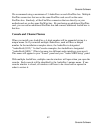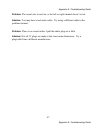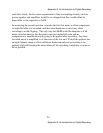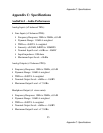Appendix B: An Introduction to Digital Recording
50
Appendix B: An Introduction to Digital Recording
Also important to the quality of a digital recording is the frequency with which the
samples are stored, called the sample rate. In order for a waveform to be faithfully
digitized, it must be sampled at a minimum of twice the highest frequency to be
stored. Failure to sample frequently enough results in a kind of distortion called
aliasing. (If you like technical issues, do some research on The Nyquist Theorem,
which explains why this happens). In addition to aliasing, sampling too slowly will
result in reduced high frequency reproduction. Your Echo product allows you to
sample sound at up to 96,000 times per second (192,000 with AudioFire12).
Once the waveform has been transformed into digital bits, it must be stored. When
sampling in stereo at 96kHz using a 24-bit word size, the system has to
accommodate 4,608,000 bits per second. In the past, storing this vast amount of
data was problematic. Today, computer-based digital recording systems record the
data directly to the computer’s hard disk. Today’s hard disks are capable of storing
large amounts of data, though the performance of hard drives can vary
substantially. The speed and size of your hard drive will be a major determining
factor in how many tracks of audio you will be able to simultaneously record and
playback.
Decibels
Audio signal levels are generally expressed in units called “decibels” which are
abbreviated as “dB”. This is a “logarithmic” scale where each doubling of signal
level is represented by an increase of 6dB. Therefore a signal of 6dB is twice as big
as a 0dB signal and a signal of 12dB is four times as big as a 0dB signal.
Since digital audio signals are represented by binary data, each bit of audio
information represents 6dB. A 16-bit number can represent a total range of 96dB
and a 24-bit number can represent a total range of 144dB (6 times the number of
bits). It’s much easier to say that one signal is 72dB less than another instead of
saying it is 1/4096 the size of the other one. It also more accurately represents the
way we hear sounds, since the smaller signal in the above example will still be
audible and not appear to be only 1/4096 as loud when we listen to it.
Just as there are different types of degrees used to represent temperature
(Fahrenheit, Celsius, etc), there are different types of decibels used to represent the


















